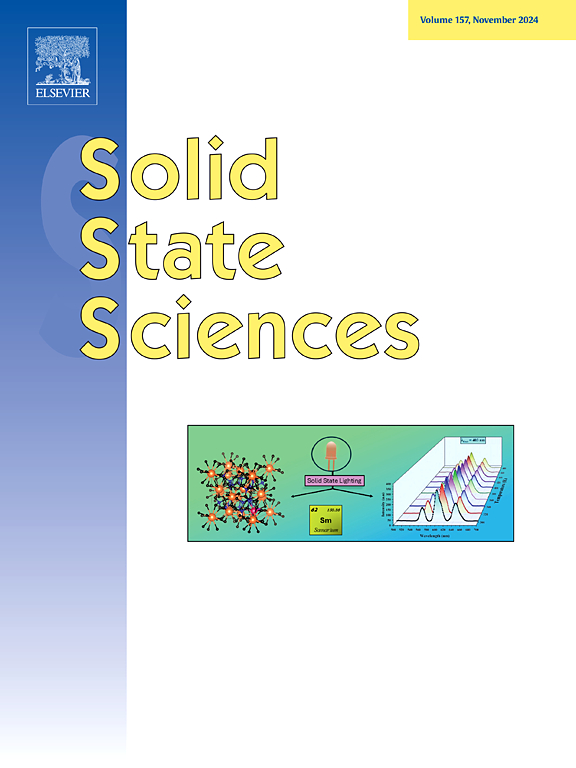Synthesis and characterization of zinc titanate-graphene oxide composites prepared under ambient and hydrothermal conditions
IF 3.3
3区 化学
Q2 CHEMISTRY, INORGANIC & NUCLEAR
引用次数: 0
Abstract
We prepare reduced graphene oxide-zinc titanate (ZTO) composite powders by mixing ZTO with 1 wt% graphene oxide (GO) in solid and liquid states under open environments, and under hydrothermal conditions. The treatment temperature was 400 °C in the first two cases and 180 °C in hydrothermal. Structural and chemical characterizations performed using XRD, SEM, BET, XPS, DRS, and PL are correlated with their photocatalytic performance. Mixing leads to significant structural and chemical changes in GO and ZTO particles but of different natures depending on the process. All the mixing routes reduce GO to r-GO. Unlike hydrothermal mixing, mixing under an open environment converts the rhombohedral ZnTiO3 to cubic Zn2TiO4 due to loss of oxygen. However, hydrothermal mixing leads to a loss in crystallinity of the ZnTiO3 particles resulting into a larger specific surface area. XPS results suggest good binding between the r-GO sheets and the oxide particles. Liquid state mixing leads to the highest reduction in bandgap, probably due to maximal oxygen vacancy formation in this process. Mott-Schottky analysis is done to estimate the charge carrier density in all the samples. EIS shows that the hydrothermally prepared composite has the smallest Rct. High surface area, less conversion to Zn2TiO4, changes in bandgap, good binding of ZTO with GO sheets, and more facile charge transfer in hydrothermally prepared composites have important implications in photocatalytic applications.

常温和水热条件下钛酸锌-氧化石墨烯复合材料的合成与表征
在开放环境和水热条件下,将氧化石墨烯与氧化石墨烯(GO)在固体和液体状态下混合,制备了还原氧化石墨烯-钛酸锌(ZTO)复合粉体。前两种情况的处理温度为400℃,水热处理温度为180℃。利用XRD、SEM、BET、XPS、DRS和PL进行的结构和化学表征与它们的光催化性能相关。混合会导致氧化石墨烯和氧化锆颗粒发生显著的结构和化学变化,但不同的性质取决于工艺。所有混合路径都将GO还原为r-GO。与热液混合不同,在开放环境下混合,由于氧的损失,菱面体ZnTiO3转化为立方Zn2TiO4。然而,水热混合会导致ZnTiO3颗粒结晶度的损失,从而导致更大的比表面积。XPS结果表明,氧化石墨烯薄片与氧化物颗粒之间结合良好。液态混合导致最大的带隙减小,可能是由于在这个过程中最大的氧空位形成。通过莫特-肖特基分析来估计所有样品中的载流子密度。EIS表明,水热制备的复合材料具有最小的Rct。水热制备的复合材料具有高的比表面积、较少的Zn2TiO4转化、带隙的变化、ZTO与GO片的良好结合以及更容易的电荷转移等特点,在光催化应用中具有重要意义。
本文章由计算机程序翻译,如有差异,请以英文原文为准。
求助全文
约1分钟内获得全文
求助全文
来源期刊

Solid State Sciences
化学-无机化学与核化学
CiteScore
6.60
自引率
2.90%
发文量
214
审稿时长
27 days
期刊介绍:
Solid State Sciences is the journal for researchers from the broad solid state chemistry and physics community. It publishes key articles on all aspects of solid state synthesis, structure-property relationships, theory and functionalities, in relation with experiments.
Key topics for stand-alone papers and special issues:
-Novel ways of synthesis, inorganic functional materials, including porous and glassy materials, hybrid organic-inorganic compounds and nanomaterials
-Physical properties, emphasizing but not limited to the electrical, magnetical and optical features
-Materials related to information technology and energy and environmental sciences.
The journal publishes feature articles from experts in the field upon invitation.
Solid State Sciences - your gateway to energy-related materials.
 求助内容:
求助内容: 应助结果提醒方式:
应助结果提醒方式:


